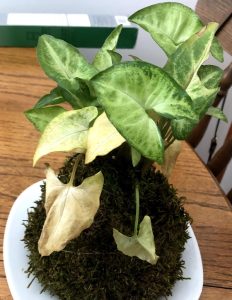Are your arrowhead plant leaves turning yellow? Do not panic since this is an indicator that your houseplant is unhappy in its growing environment. We recommend investigating the growing conditions and identifying the exact cause before thinking about fixing the issue.
Syngonium plant leaves turning yellow are more prevalent when the plant is grown indoors. But this arrowhead leaf problem can also occur to the outdoor species. We wrote this article to share the reasons for your Syngonium albo leaves turning yellow and tips to fix them.

Causes of Arrowhead Plant Leaves Turning Yellow
Natural Aging Process
The natural aging process involves the natural shedding of older leaves. As the plant matures, its lower and older leaves naturally turn yellow before eventually dropping off. This is a normal part of the plant’s growth cycle to redirect its resources toward new growth and foliage.
Pruning off the yellowing leaves is a quick solution to maintain the plant’s aesthetic appeal. Ensuring overall plant health through proper care, including appropriate watering, adequate lighting, and regular fertilization, can help minimize the impact of natural leaf aging.
To prevent excessive yellowing due to natural aging, provide consistent care to your arrowhead plant. This includes providing the plant with the right amount of water, placing it in a well-lit area with indirect sunlight, and fertilizing it according to the recommended schedule.
Incorrect Lighting Issue
Incorrect lighting conditions can lead to yellowing leaves in arrowhead plants. Insufficient light can hamper the plant’s ability to carry out photosynthesis, resulting in reduced chlorophyll production and yellowing foliage.
On the other hand, excessive direct sunlight can cause the leaves to become scorched, leading to yellowing and the development of brown patches. Adjust the lighting conditions to meet the arrowhead plant’s needs.
These plants thrive in bright, indirect light. Place them near a window with filtered sunlight or use curtains/sheer blinds to diffuse intense sunlight. If the plant doesn’t receive sufficient natural light, consider using artificial grow lights to supplement the lighting.
Observe the plant’s response to light conditions and make adjustments accordingly. Regularly rotate the plant to ensure even light exposure on all sides. Monitoring the plant’s behavior, such as leaf color and growth, will help you find the optimal lighting conditions for healthy foliage.
Overwatering Your Arrowhead Plant
Overwatering is a common mistake that can cause arrowhead plant leaves to turn yellow. When the plant is consistently exposed to excessive moisture, it can lead to root rot. The damaged roots become unable to absorb nutrients properly, resulting in yellowing and wilting leaves.
Allow the topsoil to dry out before watering your arrowhead plant again. Check the moisture level by inserting your finger into the soil. If it feels moist, hold off on watering. Ensure proper drainage by using a well-draining potting mix and a container with drainage holes to prevent waterlogging.
Develop a watering routine based on the plant’s needs and the environmental conditions. Consider factors like humidity, temperature, and the plant’s growth phase. Adjust the frequency and amount of water accordingly.
Underwatering Your Arrowhead Plant
Underwatering can also result in yellowing leaves in arrowhead plants. When the plant doesn’t receive enough water, it struggles to carry out essential functions, causing stress and leaf discoloration. The leaves may become droopy, dry, and eventually turn yellow.
Ensure your arrowhead plant receives adequate water to keep the soil evenly moist, but not waterlogged. Water the plant thoroughly until water drains out of the bottom of the pot, allowing the roots to absorb sufficient moisture.
Establish a consistent watering schedule based on the plant’s water requirements and environmental conditions. Factors such as humidity and temperature can influence the plant’s water needs. Regularly check the moisture level of the soil by inserting your finger into it.
Inappropriate Indoor Temperature
Extreme temperature conditions can negatively impact arrowhead plant leaves, leading to yellowing. Exposure to cold drafts or excessively high temperatures can stress the plant, affecting its metabolic processes and resulting in leaf discoloration.
Keep your arrowhead plant in a location where the temperature remains within the range of 60-75°F (15-24°C). Avoid placing it near drafts from windows, doors, or vents. Maintaining a stable temperature within the suitable range provides optimal growing conditions for the plant.
Monitor the temperature in the area where your arrowhead plant is located. Ensure the plant is not exposed to sudden temperature fluctuations or extreme conditions. Avoid placing it near heating or cooling sources that produce dry air.
Nutritional Deficiency
A lack of essential nutrients can contribute to yellowing leaves in arrowhead plants. When the plant doesn’t receive an adequate supply of nutrients such as nitrogen, iron, or magnesium, it can’t carry out vital metabolic processes necessary for healthy foliage.
Fertilize your arrowhead plant with a balanced, water-soluble houseplant fertilizer. Choose a formula specifically designed for foliage plants and follow the instructions for application. This will replenish the nutrient levels in the soil and promote healthy leaf coloration.
Implement a regular fertilization schedule to provide the necessary nutrients for your arrowhead plant’s growth. Monitor the plant’s response to the fertilizer and adjust the application frequency or strength if needed. Avoid over-fertilization, as it can lead to nutrient imbalances.
Lack of Humidity
Arrowhead plants thrive in high-humidity environments, and low humidity levels can cause their leaves to turn yellow. Insufficient moisture in the air leads to excessive water loss through the leaves, resulting in dehydration and leaf discoloration.
Increase humidity around the plant by using methods such as placing a tray of water near the plant, using a humidifier, or grouping plants together to create a microclimate with higher humidity. Misting the leaves with water occasionally can also provide temporary relief.
Maintain a consistent humidity level by regularly misting the plant or employing a humidifier in the vicinity. Avoid placing the plant near sources of dry air, such as heating or cooling vents. Providing adequate humidity levels will help prevent the yellowing of the leaves.
Insect Infestation
Insect infestations, such as spider mites, aphids, or mealybugs, can cause yellowing leaves in arrowhead plants. These pests feed on the plant’s sap, weakening its overall health and leading to leaf discoloration.
Identify the specific pest infestation and treat it accordingly. Use insecticidal soaps, neem oil, or natural remedies like a mixture of water and mild dish soap to control the pests. Follow the product instructions and apply the treatment as needed.
Regularly inspect your arrowhead plant for signs of insect infestation, such as visible pests, webs, or sticky residue on the leaves. Keep a clean and healthy environment for the plant, as pests are often attracted to weak or stressed plants.
Syngonium Leaf Disease
Certain leaf diseases, such as bacterial or fungal infections, can cause yellowing of arrowhead plant leaves. These diseases can be introduced through contaminated soil, poor hygiene, or excessive moisture.
Identify the specific leaf disease affecting the plant and treat it accordingly. Use appropriate fungicides or bactericides following the instructions provided. Remove and discard severely infected leaves to prevent the spread of the disease.
Maintain good plant hygiene by keeping the leaves dry and avoiding overcrowding. Ensure proper drainage to prevent waterlogged soil conditions. Use sterilized soil and clean gardening tools to minimize the risk of disease introduction.
Acclimation
When an arrowhead plant is exposed to a new environment or undergoes a change in growing conditions, it may experience acclimation stress, leading to yellowing leaves. This can occur when transitioning from a nursery to a home environment or changing light abruptly.
Provide a period of adjustment for the plant when introducing it to a new environment. Gradually acclimate it by slowly increasing or decreasing light levels, adjusting temperature, or changing watering routines. This allows the plant to adapt without experiencing severe stress.
When relocating or making significant changes to the plant’s environment, plan for a gradual transition. Monitor the plant closely during the acclimation period and make adjustments as necessary to ensure a smooth adjustment process. By providing a gentle transition, you can minimize stress and reduce the likelihood of leaf yellowing.
Final Thoughts from Experts
If you notice your Syngonium wendlandii leaves turning yellow, examine its growing conditions and environment. Fixing the issues will enable your arrowhead plant to develop striking spade-shaped leaves that mark a bold statement in your house.
Natural aging, nutritional deficiency, and incorrect lighting are the leading cause of arrowhead plant leaves turning yellow. We hope the above recommendations will help you resolve these Syngonium leaf problems.
People Who Read This Also Read:
• How Often to Water Arrowhead Plant
• Arrowhead Plant Leaves Turning White
• Arrowhead Plant Leaves Turning Pale
• Arrowhead Plant Leaves Turning Brown
• Arrowhead Plant Leaves Curling
• Arrowhead Plant Drooping (Causes & Solutions)
• How to Care for Arrowhead Plant






